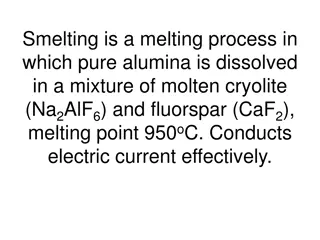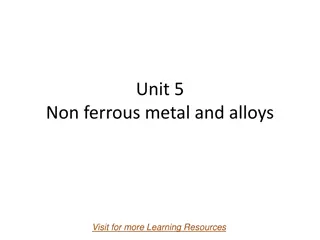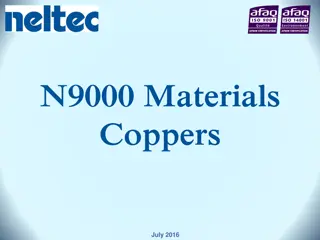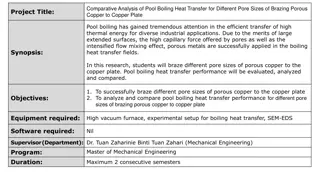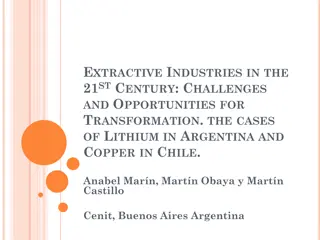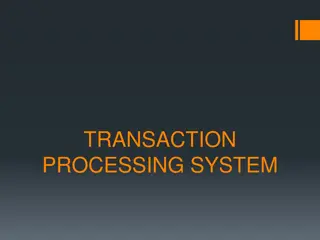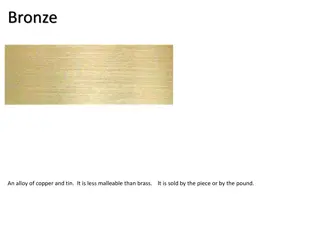Understanding Electrolysis and Copper Processing
Electrolysis is a process that uses an electrical current to move ions in an electrolyte solution. In the processing of copper ores, electrolysis plays a vital role. Copper ions leave the anode and move towards the cathode in a copper electrolysis setup. This experiment involves using a penny as the copper source/anode and a dime as the cathode, placed in an electrolyte solution while a current supplied by a 9V battery. Safety precautions need to be taken, such as wearing goggles and gloves. The process includes cleaning a penny, preparing copper wire, and creating electrodes to understand and demonstrate the principles of electrolysis effectively.
Download Presentation

Please find below an Image/Link to download the presentation.
The content on the website is provided AS IS for your information and personal use only. It may not be sold, licensed, or shared on other websites without obtaining consent from the author. Download presentation by click this link. If you encounter any issues during the download, it is possible that the publisher has removed the file from their server.
E N D
Presentation Transcript
Apply basic chemistry principles to understand the process of electrolysis Understand how electrolysis is used in the processing of copper ores
Uses an electrical current to move ions in an electrolyte solution between two electrodes In copper electrolysis, when current is applied, copper ions (Cu2+ cations) leave the anode (+electrode) and move toward the cathode (-electrode) - + Cu2+ CuSO4 Solution
In this experiment, a penny will be used as the copper source/anode, and a dime will be used as the cathode They will be placed in an electrolyte solution A current will be supplied by a 9V battery
What do you think will happen in this experiment? Write a hypothesis on worksheet
Clean a pre-1982 penny with salt/vinegar mixture, rinse with water and allow to dry
Cut a 33 cm length of 18- gauge copper wire Peel apart to separate red- and black- coated wires 33cm
Use 1.6 mm gauge setting on wire stripper to remove ~1.5 cm length of rubber coating from both ends of each wire to expose the copper filaments, being careful not to sever copper filaments
Twist filaments together tightly and fold A B C A) Exposed copper filaments; B) twisted copper filaments; and C) final product of twisted and folded copper filaments.
Make two holes in the cardboard an inch apart Push the red wire through one hole and the black wire through the other
Insert each folded end of wire into handle of matching alligator clip so that wire touches metal inside the clip handle red wire should have a red alligator clip at each end; black wire should have a black alligator clip at each end A B A) Unattached copper wires; B) copper wires attached to alligator clips.
Clip the penny into the red electrode and clip the dime into the black electrode Complete wire assembly: red and black wires pushed through cardboard with alligator clips attached and coins inserted.
OPTIONAL step to be completed before inserting wires into cardboard: Weigh each coin/copper wire assembly separately and record the mass Penny/red wire/red clips Dime/black wire/black clips
Pour 200 mL of the copper sulfate electrolyte solution into the beaker Place the wire assembly over the beaker so that the coin "electrodes" are immersed in the electrolyte solution Note: the two electrode assemblies must not touch one another.
Clip each connecting wire to the 9V battery: Clip red to positive terminal Clip black to negative terminal
Allow the electrolytic cell to operate for 30-60 minutes OPTIONAL: Record the length of time the cell was operating
Carefully remove wire assemblies and hang in an empty beaker until dry (5-10 min), being careful not to touch coins, so as not to lose any of the copper plating
Examine the coins for changes OPTIONAL: Weigh each coin/copper wire assembly and record the mass. Calculate the difference in starting and ending mass.
Initial mass of penny [g] Final mass of penny [g] Difference in mass [g] Initial mass of dime [g] Final mass of dime [g] Difference in mass [g]
Initial mass of penny [g] Final mass of penny [g] Difference in mass [g] 4.764 Initial mass of dime [g] Final mass of dime [g] Difference in mass [g] 3.549 4.371 3.988 -0.393 +0.439
Coating the dime with copper from a penny When electrical current is applied to the penny (anode), copper cations are set free in the electrolyte solution. Cu2+ ions in solution are attracted to the dime (cathode). Cathode Anode Negative Electrode Cu2+(aqueous) + 2 e- Cu(solid) Positive Electrode Cu (solid) Cu2+(aqueous)+ 2 e-
Anode slabs of impure copper are hung in a large tank Act as positive electrodes Thin starter sheets of pure copper (15 lb) are hung in between anodes Act as cathodes/negative electrodes Tank is filled with electrolyte solution Copper sulfate and sulfuric acid Electric current is applied (over 200 amperes)
Positively-charged copper ions (cations) leave the anode (positive electrode) Cations move through the electrolyte solution and are plated on the cathode (negative electrode)
Other metals and impurities also leave the anodes Drop to the bottom of the tank or stay in solution Can be collected and refined to recover other valuable metals such as silver and gold After 1-2 weeks of electrolysis, the final products are copper cathodes Weigh 375 pounds Contain 99.99% pure copper
At the end of the experiment, the dime should be coated with copper. What are the possible sources of this coating? How could you determine which sources contributed to the coating, and how much? Why do you think copper wire is used for the wire assemblies? What differences would you expect if the electrolytic experiment were allowed to run for a short time versus a long time?
What would you expect to see if you made the dime the anode and the penny the cathode, and/or used different coins in the experiment? Would you need to change anything else? To reach commercial scale, how do you think you would need to change the materials from this small experiment to make a 375-pound copper cathode?





